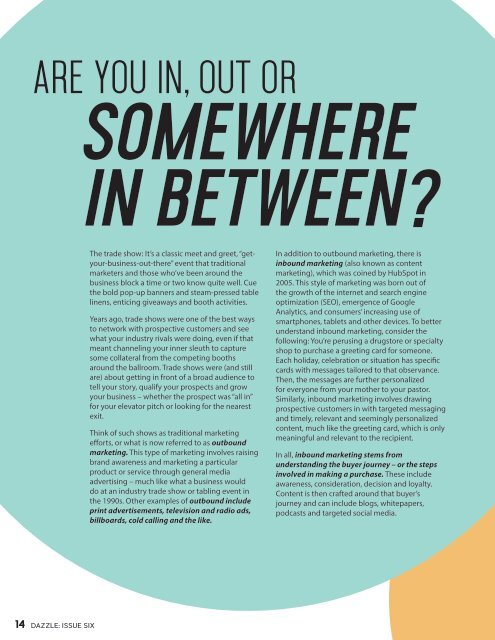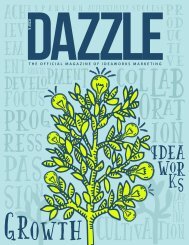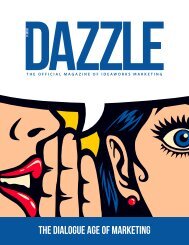Dazzle Issue 6
You also want an ePaper? Increase the reach of your titles
YUMPU automatically turns print PDFs into web optimized ePapers that Google loves.
Are You In, Out or<br />
Somewhere<br />
in Between?<br />
As you adjust and refine your marketing mix this year, you’ll want to consider which efforts<br />
you currently use and reflect on their successes and shortcomings. Outbound marketing<br />
has undoubtedly received its fair share of criticism as of late, being called a “blanketed”<br />
approach with generalized messaging. On the other hand, inbound marketing has grown<br />
in popularity amongst more and more content creators due to its highly personalized<br />
approach. But does that make one or the other the “right one” for your business?<br />
Not necessarily.<br />
The trade show: It’s a classic meet and greet, “getyour-business-out-there”<br />
event that traditional<br />
marketers and those who’ve been around the<br />
business block a time or two know quite well. Cue<br />
the bold pop-up banners and steam-pressed table<br />
linens, enticing giveaways and booth activities.<br />
Years ago, trade shows were one of the best ways<br />
to network with prospective customers and see<br />
what your industry rivals were doing, even if that<br />
meant channeling your inner sleuth to capture<br />
some collateral from the competing booths<br />
around the ballroom. Trade shows were (and still<br />
are) about getting in front of a broad audience to<br />
tell your story, qualify your prospects and grow<br />
your business – whether the prospect was “all in”<br />
for your elevator pitch or looking for the nearest<br />
exit.<br />
Think of such shows as traditional marketing<br />
efforts, or what is now referred to as outbound<br />
marketing. This type of marketing involves raising<br />
brand awareness and marketing a particular<br />
product or service through general media<br />
advertising – much like what a business would<br />
do at an industry trade show or tabling event in<br />
the 1990s. Other examples of outbound include<br />
print advertisements, television and radio ads,<br />
billboards, cold calling and the like.<br />
In addition to outbound marketing, there is<br />
inbound marketing (also known as content<br />
marketing), which was coined by HubSpot in<br />
2005. This style of marketing was born out of<br />
the growth of the internet and search engine<br />
optimization (SEO), emergence of Google<br />
Analytics, and consumers’ increasing use of<br />
smartphones, tablets and other devices. To better<br />
understand inbound marketing, consider the<br />
following: You’re perusing a drugstore or specialty<br />
shop to purchase a greeting card for someone.<br />
Each holiday, celebration or situation has specific<br />
cards with messages tailored to that observance.<br />
Then, the messages are further personalized<br />
for everyone from your mother to your pastor.<br />
Similarly, inbound marketing involves drawing<br />
prospective customers in with targeted messaging<br />
and timely, relevant and seemingly personalized<br />
content, much like the greeting card, which is only<br />
meaningful and relevant to the recipient.<br />
In all, inbound marketing stems from<br />
understanding the buyer journey – or the steps<br />
involved in making a purchase. These include<br />
awareness, consideration, decision and loyalty.<br />
Content is then crafted around that buyer’s<br />
journey and can include blogs, whitepapers,<br />
podcasts and targeted social media.<br />
14 DAZZLE: ISSUE SIX DAZZLE: ISSUE SIX 15

















